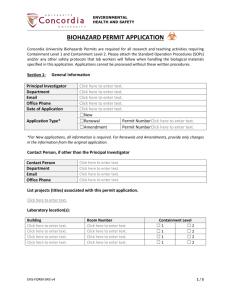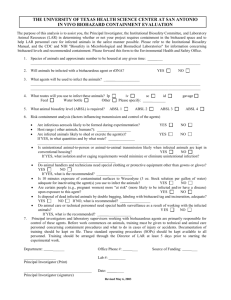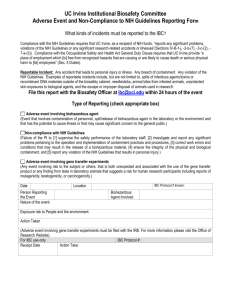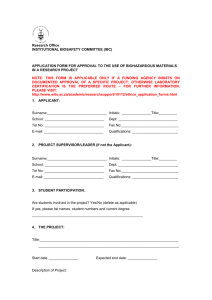University of Guelph
advertisement
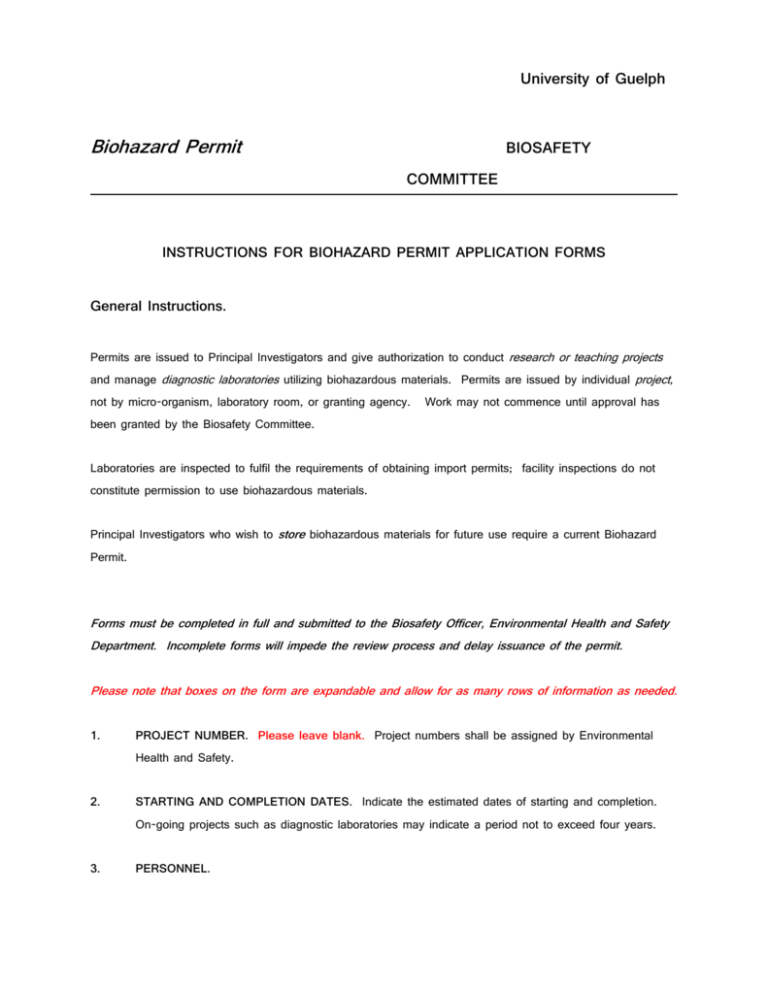
University of Guelph Biohazard Permit BIOSAFETY COMMITTEE INSTRUCTIONS FOR BIOHAZARD PERMIT APPLICATION FORMS General Instructions. Permits are issued to Principal Investigators and give authorization to conduct research or teaching projects and manage diagnostic laboratories utilizing biohazardous materials. Permits are issued by individual project, not by micro-organism, laboratory room, or granting agency. Work may not commence until approval has been granted by the Biosafety Committee. Laboratories are inspected to fulfil the requirements of obtaining import permits; facility inspections do not constitute permission to use biohazardous materials. Principal Investigators who wish to store biohazardous materials for future use require a current Biohazard Permit. Forms must be completed in full and submitted to the Biosafety Officer, Environmental Health and Safety Department. Incomplete forms will impede the review process and delay issuance of the permit. Please note that boxes on the form are expandable and allow for as many rows of information as needed. 1. PROJECT NUMBER. Please leave blank. Project numbers shall be assigned by Environmental Health and Safety. 2. STARTING AND COMPLETION DATES. Indicate the estimated dates of starting and completion. On-going projects such as diagnostic laboratories may indicate a period not to exceed four years. 3. PERSONNEL. The Principal Investigator must be a member of faculty or professional staff. Only one person can serve as Principal Investigator. Co-investigators are named under Associates. The Designate must be a regular member of faculty, professional staff, or senior technician. Students, post-doctoral fellows, casual workers, and unpaid persons, e.g., visiting faculty, may not be named as designates. Emergency contact(s) must be available to attend to after-hours problems. There must be an adequate number of contacts to cover for vacation, illnesses, and other absences. Emergency contacts will be registered with Security Services who are the first responders to campus incidents. All contact numbers will be kept confidential. Investigative Staff. List all persons who will be working with the biohazardous materials. For Principal Investigators, submit biosafety qualifications and experience and/or resume. For proposals wishing to utilize the CL-3 facility, submit CL-3 qualifications and/or resume of each staff member who will be entering the facility. 2. RESEARCH PROJECT or COURSE TITLE and SUMMARY OF PROJECT. Title. Indicate the title of the course, research project, or diagnostic laboratory. Project/Course Summary. Describe the project such that persons who are not expert in the field can evaluate the project. Funding Sources. List all sources of funding. If there is no funding for the project, indicate “not funded”. Teaching projects are funded by the teaching program. Peer Review. Peer review is required for all projects. If the peer review is not performed by an external granting agency (e.g., Canadian Institutes of Health Research, Natural Sciences and Engineering Research Council, and the Social Sciences and Humanities Research Council), please attach documentation obtained through the Office of Research. Additional information regarding peer review may be obtained from the Director, Research Risk Management, Office of Research. Teaching projects are reviewed by the appropriate curriculum committee Use of animals, radioisotopes, and/or human subjects. Indicate the relevant certificate/permit numbers. 3. BIOHAZARDOUS AGENTS OR MATERIALS SUMMARY. Risk Groups and Containment Levels. Risk groups and containment levels may be obtained from the Public Health Agency of Canada Office of Laboratory Security (human pathogens), the Canadian Food Inspection Agency (animal and plant pathogens), material safety data sheets, and suppliers such as American Type Culture Collection. Microorganisms. Microorganisms: specify genus and species; Type: specify bacteria, virus, etc.; Pathogenic to: specify all that apply - human, animal (indicate type), and/or plant (indicate type); Risk Group: specify the risk group; Proposed Containment Level: indicate containment level. Cell Cultures. Cell type: indicate species; Primary or Established: indicate whether it is a new cell line or an established one; Known Pathogens: if the cell line is known to be infected with pathogens, indicate which pathogens; Risk Group: specify the risk group; Proposed Containment Level: indicate containment level. Human and Non-Human Primate Source Material. Substance: indicate the type of material (organ, blood, bone, etc); Species: indicate whether human or species and common name of non-human primates; Source: indicate from where the material was obtained; Risk Group: specify the risk group; Proposed Containment Level: indicate containment level. Potentially Infectious Animal Source Material. Substance: indicate the type of material (organ, blood, bone, etc); Species: indicate the species and common name; Source: indicate from where the material was obtained; Risk Group: specify the risk group; Proposed Containment Level: indicate containment level. Biological Toxins. Toxin: specify the name of the toxin; Source: indicate from where the material was obtained; Risk Group: specify the risk group; Proposed Containment Level: indicate containment level. Recombinant DNA. Host organism: specify the name of the host; Vector: indicate the corresponding vector; Gene(s): indicate the source of the genes to be cloned or expressed; Risk Group: specify the risk group; Proposed Containment Level: indicate containment level. 4. LOCATION OF PROJECT. 4.1 Campus sites. Building. Indicate building number and name. Room Number. Indicate each room in which the biohazardous material is used or stored. Use a separate line for each room number. Type of Facility. Indicate whether it is a laboratory, biological material freezer storage area, growth room, greenhouse, animal facility, etc. Shared space. Indicate if the areas where biohazardous materials are used and/or stored are shared with other University personnel. If the area is under the control of another Principal Investigator (PI), then the PI’s signature is required. If the area is a communal area such as a freezer room then the Departmental Chair’s or Director’s signature is required. 4.2 Off-campus sites. Description of site. Describe the site (university, hospital, clinic, etc) Type of facility. Specify use of facility (animal holding area, laboratory, examining room, storage facility, etc) Owner. If the property is not owned by the University, specify the owner. Shared space. Indicate if the areas where biohazardous materials are used and/or stored are shared with others. A facility manager’s signature is required. 5. BIOLOGICAL SAFETY CABINETS. Indicate location of the biological safety cabinets by room, the model and serial number, date of last certification, and the responsible party. Building. Indicate building number and name. Room Number. Indicate each room in which the biohazardous material is used or stored. Use a separate line for each room number. Model and serial number. Indicate the model and serial number as shown on the manufacturer’s name plate. Date of last certification. Indicate the date of last certification as recorded on the certificate posted on the cabinet. Person Responsible. Indicate the person responsible for maintenance and repair of the cabinet. Phone Number. Indicate the extension / phone number at which the responsible person can be reached. 6. STEAM STERILIZERS (AUTOCLAVES). Indicate the location, last inspection date, responsible party, and biological indicator verification information. Building. Indicate building number and name. Room Number. Indicate each room in which the biohazardous material is used or stored. Use a separate line for each room number. Person Responsible. Indicate the person responsible for maintenance, repair, sterilization verification, and record keeping for the sterilizer. Frequency of Biological Indicator Verification. Indicate how often the sterilizer is tested using spore strips/vials. Location of cycle and verification records. Indicate the building and room number where records are stored. 7. EXPERIMENTAL PROCEDURES AND SAFETY PROTOCOLS. For each procedure, indicate how the biohazard will be handled safely. Examples of procedures that produce aerosols include centrifugation, homogenization, sonication, grinding, blending, pipetting, intranasal inoculation, handling lyophilized material, spattering, transferring cultures etc. Indicate any use of sharps. 8. PERSONAL PROTECTIVE EQUIPMENT. Specify any use of personal protective equipment, e.g., gloves, goggles, lab clothing, etc. and the method of decontamination. 9. RESPIRATORY PROTECTION. Indicate if respiratory protection will be used. All persons using respiratory protection require registration in the Respiratory Protection Program administered by Environmental Health and Safety. 10. EMERGENCY RESPONSE PLANS. Describe response plans for all anticipated emergencies. 11. DECONTAMINATION AND WASTE MANAGEMENT PROTOCOLS. Describe protocols for each specific type of contaminated material. 12. TRANSPORTATION OFF SITE. Persons transporting infectious or toxic materials (dangerous goods) require a Transportation of Dangerous Goods training certificate. Training can be arranged through Environmental Health and Safety. Dangerous Goods must be transported by common carrier or in University-owned vehicles. TRANSPORTATION ON SITE. Describe how the material will be transported between room and/or buildings through public spaces. Include means of packaging, e.g, sealed plastic containers and means of transport, e.g., walking, using a cart, using a university vehicle. 13. IMPORT/EXPORT. Indicate if you intend to import or export biohazardous materials per the requirements of the Public Health Agency of Canada and/or the Canadian Food Inspection Agency. Note that for many biohazardous materials, a permit is required from both agencies. Certain substances, primarily but not exclusively RG 3 and RG 4 materials, require an export permit. TRANSFER. Principal Investigators may be asked for culture strains by colleagues at the University or at other facilities. All transfers of biohazardous materials must be approved by the Biosafety Committee. Depending on the nature of the transaction, consult with the Office of Research to determine if a Material Transfer Agreement (MTA) may required. Natural isolates collected by the PI do not need an MTA. 14. SECURITY. Describe how the biohazardous materials will be secured from unauthorized use and theft. Describe how the work areas will be secured from unauthorized access. If screening of personnel is required, for example, working with select agents under a grant from an agency based in the United States, describe the nature of the screening. INVENTORY RECORDKEEPING AND CONTROL. Describe the method of recordkeeping, e.g., computer database, card file, etc. Describe how inventory is controlled, e.g., authorized persons only inputting data, password protection, etc. 15. MEDICAL SURVEILLANCE. Describe the medical surveillance plan specific to this project. Indicate if prophylactic measures and/or medical screening are mandatory. Information on medical surveillance programs can be obtained from Occupational Health Services. 16. PRINCIPAL INVESTIGATOR’S CERTIFICATION. Applications must be signed by all parties. Unsigned applications will not be processed. Biohazard Permit SUPPLEMENTAL FORMS Forms BS-1 to BS-7: Biohazardous materials. Supplemental forms provide detailed information about the biohazardous materials to be used and the use of animals. Please attach any relevant information for the committee that is in support of the application. Form BS-8: Change Request form. Significant changes to the Biohazard Permit require approval by the committee before commencement of the changes. Form BS-9: Annual Status Report form. An Annual Status Report must be filed each year a project is active. Form BS-10: Laboratory Decommissioning Report. When closing down a project and/or vacating the premises, the decommissioning report must be completed. Form BS-11: Risk Group 1 Only. This must be completed when using Risk Group 1 organisms in order to comply with granting agency requirements.

